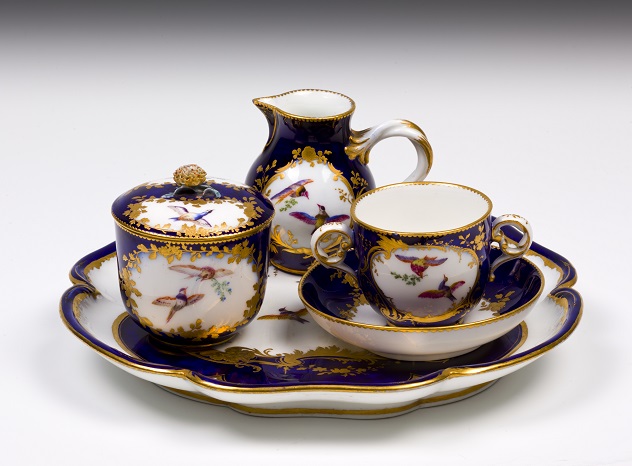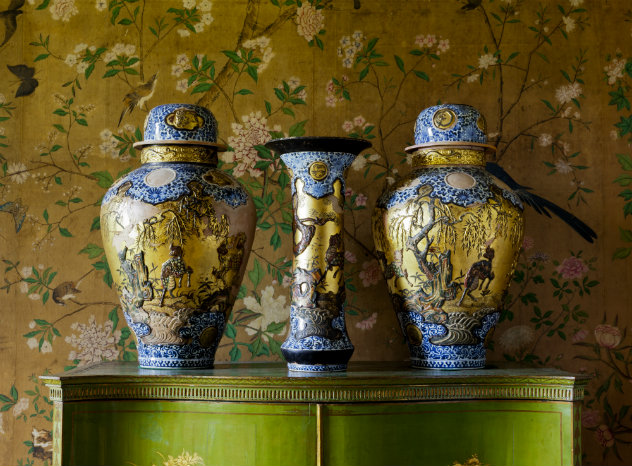Vase
Melchior d'Hondecoeter (Utrecht 1636 - Amsterdam 1695)
Category
Ceramics
Date
1762 - 1764
Materials
soft-paste porcelain, polychrome enamels, gold
Measurements
42 x 25 x 16 cm
Place of origin
Chelsea
Order this imageCollection
Upton House, Warwickshire
NT 446369.7
Summary
Jar and cover from a seven-piece garniture of pot-pourri jars, soft-paste porcelain, inverted pear-shaped on four scroll feet with two pierced scroll-handles, pierced neck and cover, the reserved panels on a crimson-coloured ground with tooled floral gilding painted in polychrome enamels with a disheveled Alpheus, a river god, who smiles lovingly as he embraces a vaporous cloud which supports a startled nymph, Arethusa, and her companion, Artemis, a moon goddess. An amorino holds a torch above them, the reverse with peacock, turkey and other birds in the manner of the Dutch artist Melchior de Hondecoeter (1636-95), maker's mark a gold anchor mark; Chelsea, London, England, circa 1762-4. The image faithfully copies an engraving entitled ‘Alphée et Aréthuse’ by Étienne Fessard (1714-74) after a painting by Pierre-Charles Trémolières, which was announced in the ‘Mercure de France’ in October 1737 at the time of its publication. The same scene, though somewhat altered, later appeared on a Vase ‘à têtes de sphinx’, c. 1773, in the Wallace Collection, and a seau ‘à verre’ in the Louis XVI service, 1783 (R. Savill, ‘The Wallace Collection: Catalogue of Sèvres Porcelain ’, 1988, vol. I, p. 418). The composite depictions of farmyard fowl and pheasants in formal landscapes, including peacocks and turkeys in the 17th-century manner of Melchior de Hondecoeter (1636-95) or Francis Barlow (1626-1704), Multae et diversae avium species, London, 1650-55, were possibly also based on engravings by Joseph Sympson (1710-50) after paintings by Marmaduke Craddock (c.1660-1716), published in 1741-3.
Full description
This celebrated seven-piece Chelsea crimson-ground garniture is formed of four unrelated models, all perfume jars with covers, typically sold as singletons, pairs or triads. Each ultimately derives from a Vincennes model, the 'pot-pourri à jour', introduced around 1752, an example of which was copied by Chelsea around 1758–62. The elaborate handles of pierced and interlaced scrollwork imitate French rococo ormolu or Sèvres porcelain prototypes. The garniture exemplifies the ever-more capricious vases in an extreme rococo produced at Chelsea between 1759 and 1764. This style, in the ‘Anti-gallican spirit’, made in direct competition with France, with whom England was then at war, was also manifested in inexecutable ‘modern’ designs for woodworkers by the London carver Thomas Johnson and bizarre designs for silver published by John Linnell. The voyeuristic subject matter, the most erotic ever painted on English porcelain, is primarily executed in a lush palette of puce, lilac and pink. The central jar depicts 'Alphée et Aréthuse', from an engraving after Pierre-Charles Trémolières by Étienne Fessard, published in 1737 – a decade before it appeared on Sèvres porcelain. Next in size, the pear-shaped jars depict 'Zéphire et Flore' and 'Jupiter et Lèda', from engravings by Jean-Baptiste Tilliard after Charles Michel-Ange Challe, published in October 1761. The other jars are decorated after paintings by François Boucher. The inverted pear-shaped vases are painted with 'L’Amour désarmé', after an engraving published in April 1761, and 'La Mort d’Adonis,' engraved in 1742. The scenes on the smallest are taken from 'Le Repos de Diane' and 'L’Amour désarmé'. The reverse scenes, of peacocks and barnyard fowl, are in the manner of Melchior de Hondecoeter (1636–95), a painter much adored by the English aristocracy. Boucher’s amorous mythologies failed to find favour in England in the eighteenth century, suggesting that the vases were a bespoke commission. The garniture’s early history is a mystery, but it has been well documented since 1857, when it was exhibited at the Bond Street antiques dealers Messrs Falcke & Co. It was part of a collection of Chelsea porcelain ‘long preserved’ at Knole, Kent (nt), by Arabella, Duchess of Dorset (1767–1825), widow of the 3rd Duke, which was sold by her daughter Lady Mary Sackville for £3,000. The Duchess’s mother, Lady Cope, had purportedly received the garniture from George III in 1767. However, the subject matter was more appropriate to an English Casanova such as the 3rd Duke, one of the century’s great womanisers, or a courtesan. In 1769, the husband of Lady Cope’s sister, Sir George Warren, purchased the Knightsbridge house and furnishings belonging to the Duchess of Kingston, the former Elizabeth Chudleigh (1720–88). Famous for appearing nearly naked as Iphigenia at the Venetian Ambassadors’ Masquerade in 1749, she was bigamously married to Evelyn Pierrepont, 2nd Duke of Kingston-upon- Hull, and Augustus Hervey, 3rd Earl of Bristol, known as ‘the English Casanova’. Having passed through the collections of Sir Dudley Coutts Marjoribanks, 1st Baron Tweedmouth; the brewer Michael Arthur Bass, 1st Baron Burton; and William Waldorf Astor, 1st Viscount Astor of Cliveden, the garniture was sold at auction in 1920 for 6,200 guineas to a St James’s antiques dealer, Albert George Amor. In 1922, Amor sold it to the founder of Shell Oil, Marcus Samuel (1853–1927), created Viscount Bearsted in 1925. He commissioned a George II-style cabinet to display it either in his London house or country estate, The Mote, Maidstone, Kent. Viscount Bearsted’s collection was inherited by his son, Colonel Walter Horace Samuel, 2nd Viscount Bearsted (1882–1948), and installed at Upton House, which he acquired in 1927. Text adapted from Patricia F. Ferguson, Ceramics: 400 Years of British Collecting in 100 Masterpieces, Philip Wilson Publishers, 2016.
Marks and inscriptions
anchor painted in gold, two numbered '3' and '6' in red enamel
Makers and roles
Melchior d'Hondecoeter (Utrecht 1636 - Amsterdam 1695), painter
References
Ferguson 2016: Patricia F. Ferguson, Ceramics: 400 Years of British Collecting in 100 Masterpieces, Philip Wilson Publishers, 2016, pp. 108-9



